In about 1798 a small group of Scots-Irish immigrants connected to the Associate Presbyterian Church built a small log cabin chapel near the downtown area of New Castle, Pennsylvania. It was situated along Beaver Street in the same approximate location where the St. Mary’s Catholic Church (Mary, Mother of Hope) stands today. The Associate Presbyterians or “Seceders” had broken away from the mainstream Presbyterian Church back in the early 1700’s.
In about 1826 this congregation abandoned the chapel and relocated to Pittsburg Street (later East Washington Street) on the East Side, where they built a stone church and laid out a new small cemetery. In 1858 a national merger of the Associate Presbyterians and Associate Reformed Presbyterians took place, which led to the combining of many churches. The congregation on Pittsburg Street survived a few more years but was finally closed in about 1865. The cemetery was closed to new burials and the “Old Stone Church” was demolished about a decade later. A large wooden fence was also erected around the cemetery.
Col. Oscar L. Jackson (1840-1920), who served with distinction with U.S. Army during the Civil War, took the lead with preserving the small cemetery. Jackson, who studied law with attorney Samuel W. Dana in New Castle, was admitted to the bar in 1868. Jackson, a Republican, soon opened his own law practice in New Castle and became actively involved in politics. He served as the Lawrence County District Attorney from 1868-1871, subsequently assisted on a state commission for laws from 1877-1878, and served two terms in the U.S. House of Representatives from 1885-1889. He then returned to his law practice in New Castle and became heavily involved in the community affairs.
Jackson petitioned the court, likely in the late 1860’s, to form a trust to provide for the perpetual care of the small cemetery. The initiative was granted and stipulated that a lone trustee would oversee the cemetery, but that person must have a relative buried in the cemetery. Samuel S. Jackson (1815-1911), Oscar Jackson’s father, served as the first trustee of the cemetery. Oscar Jackson later became trustee after his father died in 1911.
In the late summer of 1889 the widening Pittsburg Street on the East Side was undertaken. The wooden fence around the cemetery was removed and part of the property was taken by the city for the street project. The New Castle News of Wednesday, August 14, 1889, reported, “Only a portion of the lot was used for burying purposes, but this part was crowded to its fullest capacity, so that there were hundreds of people buried there. Not more than 30 graves are marked with stones. The location of a few others are known, but the greater part are forgotten while a few have been removed. The remains of two persons connected with the Paisley family were taken up only three weeks ago.”
The same article went to elaborate on those that are buried there with, “Down in a secluded spot is the grave of Dr. Samuel Steen, and an old resident recalled to the scribe a great military event that took place on the occasion of the interment. There was a tremendous crowd and it is even said that the windows in the little stone church standing near were cracked with the noise of the cannon. Dr. Steen was a medical purveyor in the Union army and was killed and buried at Saltello during the Mexican war. His remains were removed to this place in 1848. Not far from this grave is a large stone raised in memory of James Jackson, Sr., who was buried in 1838. James Jackson Sr., was none other than the grandfather of Hon. O. L. Jackson, of this city. Nancy M. Jackson is buried near, interred in 1854. She was the wife of S. S. Jackson. Side by side are the graves of Isaac and Elizabeth Rose, father and mother of the well known and aged Isaac P. Rose, of Shenango township, and John Stritmater, father of the Stritmater Brothers, is also buried here. He died December 18th, 1849, aged 33 years. Rebecca Alford, mother of Rev. John Alford, of Beaver Falls, was buried in this ground in 1850. The grandmother of Captain William H., Robert W. and Leander W. McCandless was interred here, as was also ’Squire James Carnes, who early in this century was perhaps the most prominent man in the county…”
Discussion of relocating the graves had begun as early as the late 1890’s. The church and its cemetery were located in what was once a rural spot away from the center of town, but over time the area became quite crowded with homes and businesses. The small burial ground apparently became quite an eyesore as well. About five other older cemeteries in New Castle, including the old Methodist Cemetery on Jefferson Street, had already had their graves removed to Greenwood Cemetery on the West Side in previous years.
Finally, in early 1921, various parties decided to form a plan to relocate the graves in the Old Stone Church Cemetery to Greenwood Cemetery. The New Castle News of Monday, April 4, 1921, reported, “David L. Jackson, trustee of the Old Stone Church Cemetery on East Washington street, presented a petition to Judge Emery this morning setting forth that a lot had been purchased in Greenwood cemetery and arrangements had been made for the removal of bodies to the new location. Judge Emery fixed the sixth day of June as a time for hearing the application. The Stone church cemetery received its name from an old stone church, that formerly stood in front of the cemetery on East Washington street, but has long since been removed. The cemetery, one of the oldest in the city, has long stood in the way of opening Cunningham avenue. Now that the Junior High school is to be located on that street, it is very desirable that it be opened.”
Excavation work at the Old Stone Church Cemetery began in late June 1921. An article from the New Castle News of Thursday, June 23, 1921, explains the work: “As each grave is opened the workmen dig until traces of a body are found when they stop and begin on another grave. When all the graves have been opened the work of removing the bones will begin. Coffins, all of uniform shape and bearing numbers coinciding with those on the tombstones, will be used to carry them to their new resting place.”
The New Castle News of Tuesday, June 28, 1921, reported, “The announcement of the finding of the body of Major Dr. Steen encased in a metallic casket at the Old Stone church cemetery, brings out the fact that the Steen family has had a member, which has served in the Mexican, the civil and the world war. Major Steen was in the American army that fought in Mexico in 1848 and was killed in action in action. His body was encased in the metallic casket and brought back here and buried in the Old Stone church cemetery. He was the uncle of the grandfather of Dr. William L. Steen, city health officer and bacteriologist. The father of Dr. Steen, William J. Steen was a veteran of the civil war. Dr. Steen was a captain and served during the world war.”
By early July 1921 the project was completed and a total of forty-eight sets of remains had been re-interred in Greenwood Cemetery. It is presumed that no remains were left behind. Part of the old cemetery was used in the improvement of East Washington Street, but the remainder was left vacant and became the property of the Greenwood Cemetery Association.
Within a few years a plan was launched to convert the vacant lot into a city park. The New Castle News of Friday, March 2, 1928, reported, “Council, in regular session at City Hall today, reported favorably from committee an ordinance providing for the condemnation and purchase of ground situated between East Washington street and Cunningham avenue which is to be known as Jackson Park, in honor of the late Colonel Jackson. The land formerly was used as a cemetery and is to be developed in the future when the city cuts a street through from Cunningham avenue to East Washington street. The cost of the land will be $5,000 and is owned by the Greenwood Cemetery Association.”
Legal issues slowed the plan but sometime in 1930 the city formally acquired the property. The New Castle News of Friday, October 3, 1930, reported, “(Planning Commission member) Robert Hainer and (City Treasurer) C. L. McMillen appeared before councilmen in the city building today and requested solons to take immediate action whereby the old cemetery in East Washington street can be converted into Jackson Park. Council will act on the request Monday. The land was bought for $5,000 and the plot named Jackson Park. (Max) Ludwig company has billboards on the East Washington street side and McMillen as spokesman asked they be removed and work started so the park can be ready for occupancy next spring. The plot also provides for a direct route from East Washington street to Cunningham avenue should the city desire a route.”
Louis Genkinger, director of city parks, began efforts in the spring of 1932 to spruce up the property for public use. The property was cleaned up and a stone walkway and wooden benches were added. In July 1932 the city council decided against renewing the rent ($50 a year) for the Max Ludwig Company and gave the firm thirty days to remove several large billboards from the property. In June 1933 city employees built about twenty concrete benches, two of which were placed in Jackson Park. They replaced the wooden benches which were often the target of thieves and vandals. Within the next few years flowers, shrubs, and trees were planted and the park became a very beautiful spot. A roadway (later known as Lower Cunningham Avenue) was also cut through the middle of the property to connect East Washington Street with Superior Street.
After the outbreak of World War II various communities and neighborhoods sought to erect monuments or honor rolls to salute local residents serving in the military. A committee was formed in late 1943 with plans to erect an honor roll on the East Side of New Castle. Jack M. Dunlap, the longtime County Probation and Parole Officer, was named chairman of the committee, while Mrs. Grace Emery served as treasurer. Grace and her husband Jake Emery operated a neighborhood grocery store at the corner of Oak and Ray Streets. Some newspaper reports mention that “Walter Knoblock” – presumably Walter J. Knobloch Sr. of Chestnut Street – served as secretary.
The plan was to erect the honor roll in Jackson Park and fundraising efforts were soon underway. The New Castle News of Thursday, November 4, 1943, reported, “At the meeting of the East Side Honor Roll committee, comprising the districts in the third and fourth wards not previously covered, it was planned to erect a permanent stone monument in Jackson park, which lies along the lower side of East Washington street, between Oak and Chestnut streets. For the present, a glass-enclosed case will be placed on the monument, containing the names of the men and women from that district in service, and after the close of the war a bronze tablet will be placed on the monument, which will make a permanent record of those who serve their country… A construction committee, consisting of Joseph A. Reeher, Lawrence A. Quehl and Charles E. Patterson, was named.”
The New Castle News of Saturday, December 11, 1943, provided details of the proposed honor roll: “At a meeting of the central East Side honor roll committee, held at the court house, arrangements for the honor roll and memorial to the from the lower East Side section were completed… The stone from which it will be made was taken from the old Lake farm in Slippery Rock township, near Portersville, and formerly was the old fireplace of the home. The top stone is eight feet long and two feet square and is a fine quality of stone. It weighs two tons. It will be erected just as it was in the fireplace, with the recess that the top and sides form, holding the honor roll, which will be four by seven feet and will be covered in glass. It will be set back about 20 feet from East Washington street and will be enclosed by a circular walk, with a flag pole in the center of it. The monument will be erected on a concrete base, and there will be a concrete slab in front 8 by 16 feet in extent. Mooney Brothers will start the construction work in the near future. The cost of the memorial will be around $700, of which $450 has already been subscribed.”
Ground was broken for the East Side Honor Roll on Monday, December 13, 1943, but construction efforts were apparently delayed for a while. The completed monument was formally dedicated on Sunday, October 29, 1944. Mayor John F. Haven and a handful of other city and county officials were on hand for the ceremony.
The New Castle News of Monday, October 30, 1944, reported, “Hon. John G. Lamoree, judge of Lawrence county courts, in his dedication of the Honor Roll, Flag, Flag Pole, Eagle, and tribute to the Gold Star Mothers, spoke of those in the armed forces, and what we needed to do at home, and although they had nothing to do with instigating the war, they were carrying on to bring it to an early and successful close. He admired the splendid honor roll erected of stone, and of its permanency; also commended the Junior Commandos for their splendid assistance in the project. C. W. Herman Hess, master of ceremonies, spoke of the arrangements for erecting of the Honor Roll, and thanked those who had helped in its construction, some of whom contributed their labor and time… There are 598 names within the cabinet, including ten gold stars for those who have made the ultimate sacrifice. Clifford Humphrey, Francis Black, William L. Holier, whose names are on the Honor Roll, home on furlough, were presented.”
Jackson Park became a popular summer rest area for East Side residents walking to and from the downtown area. The New Castle News of Wednesday, June 19, 1946, reported, “One of the coolest spots in town these afternoons seems to be the benches of the little park in the 500 block of East Washington street known as Jackson Park. Pedestrians ascending East Washington street, tarry a few moments on the benches and then continue their journey much refreshed after the rest. City Forrester Owen Fox has the park in tip top shape, making it an asset to the city.” A few years later, in June 1950, an ornate stone drinking fountain was built at the park.
The honor roll – and Jackson Park in general – was a constant target of ignorant and unpatriotic vandals. The New Castle News of Saturday, April 24, 1971, reported, “Located in Jackson Park on E. Washington St., the memorial, made of stones from a log cabin, was put on the site in honor of deceased servicemen from the East Side area. Names of the men were contained in the concrete block structure. A sheet of glass protected them. Vandals, however, have broken the glass and removed the names. Oliver Davis of 702 Hazen St. told The News the memorial was once a fireplace in a log cabin at Grant City near Rose Point. June Leight, his second cousin, who was born in the cabin, was 93 when she died recently, Davis said, which makes the fireplace more than 100 years old. Davis said the fireplace was quarried out of Muddy Creek by his great-great-grandfather. When the cabin was dismantled sometime later, the fireplace was the only thing remaining. The fireplace was then used to construct the memorial on the top of E. Washington St. hill. Maintenance of the park is performed by the city. Karl H. Chandler, director of veterans affairs, said the names could be replaced because he has the list of the servicemen in his office.”
The honor roll was repaired in 1971, but was periodically defaced or damaged in the years since. Members of the Veterans of Foreign Wars Post No. 522 generously volunteered their time and renovated the stone structure in the summer of 1987. Others citizens have become involved from time to time to help maintain the monument and the small park. Today, while still standing, the monument is devoid of any plaques or markers and most people who pass by have no clue to its origin. Jackson Park is also unmarked by any sign but is still maintained by the city.
 Jackson Park along East Washington Street, the former site of the Old Stone Cemetery. (Apr 2016) |
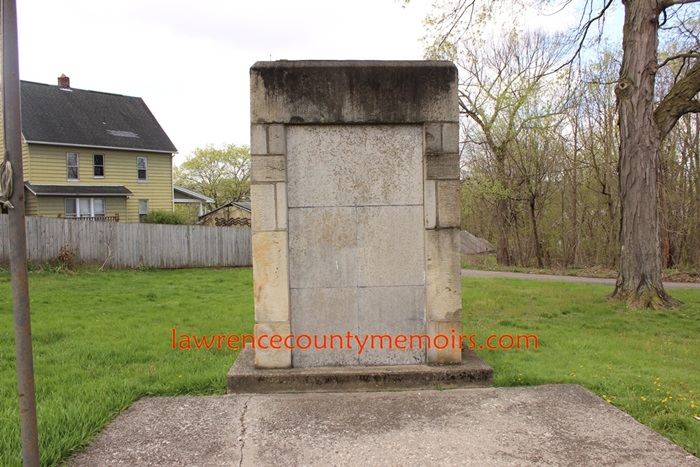 (Apr 2016) | 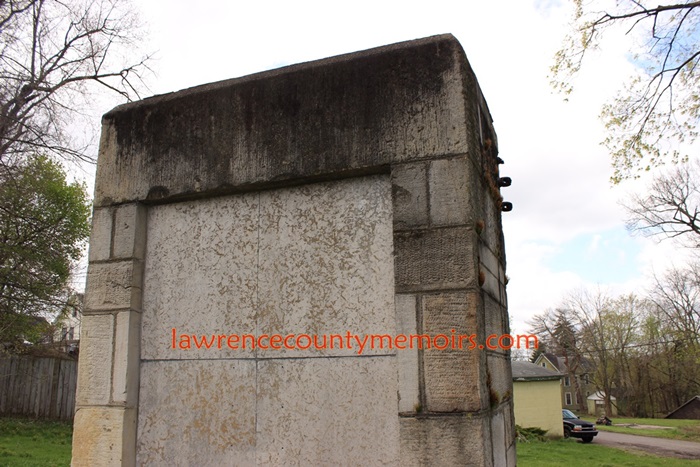 (Apr 2016) |
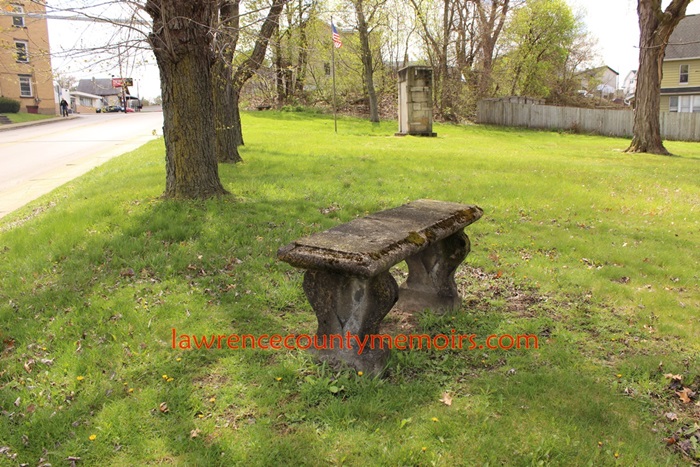 (Apr 2016) |




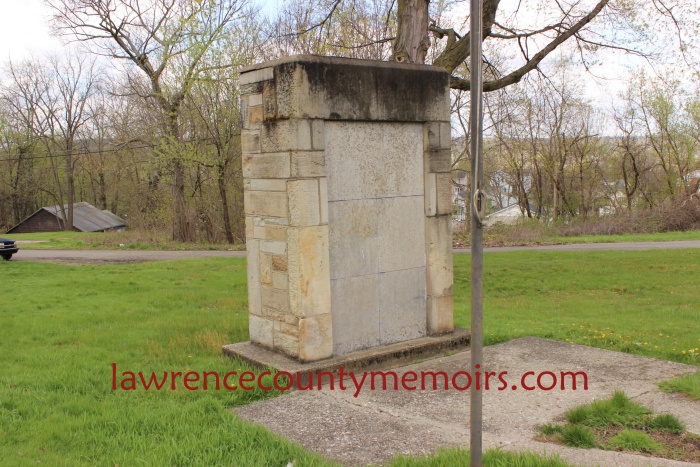
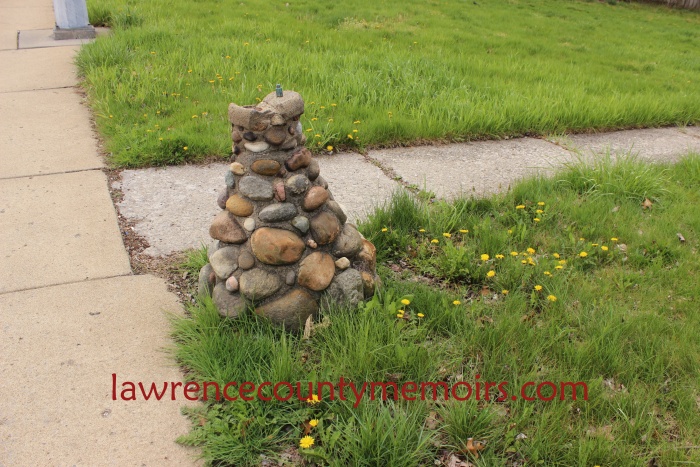
Comments
Kevin Hughes #
Thanks for another great and interesting story!
Joneta Burke #
Your research brings your stories to life. Are the names able to be seen on the monument, I can not tell from the picture? This must have been a beautiful place back in the day, and the water fountain and bench sure do add some old fashion charm to the park.
Comment